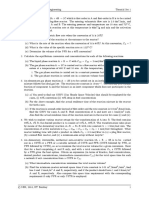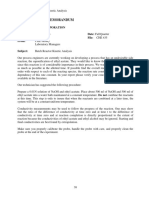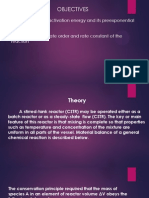Batch CSTR Experiment
Batch CSTR Experiment
Uploaded by
Naeem YounisCopyright:
Available Formats
Batch CSTR Experiment
Batch CSTR Experiment
Uploaded by
Naeem YounisOriginal Title
Copyright
Available Formats
Share this document
Did you find this document useful?
Is this content inappropriate?
Copyright:
Available Formats
Batch CSTR Experiment
Batch CSTR Experiment
Uploaded by
Naeem YounisCopyright:
Available Formats
Experimental Determination of Kinetic Rate Constants Using Batch and CSTR Reactors
CHE-431 UNIT OPERATIONS LAB I
Department of Chemical Engineering University of Tripoli Libya
Instructor
Dr. A. A. Ballut
Spring Semester / 2012
CHE-431 UNIT OPERATIONS LAB I / SPRING 2012
Experimental Determination of Kinetic Rate Constants Using Batch and CSTR Reactors
Dr. A. A. BALLUT
In this experiment, the use of both a batch reactor and a CSTR will be demonstrated to generate data for the determination of kinetic parameters. The reaction The reaction selected in this experiment is the saponification of ethyl acetate. This reaction is elementary and second-order. The reaction equation is
NaOH + CH 3 COOC 2 H 5 CH 3 COONa + C 2 H 5 OH
A + B The apparatus
+ D
The apparatus is the Armfield continuous stirred tank reactor which is designed to study the kinetics of a chemical reaction in this type of reactor (as well as the special case when it is run as a batch reactor). It can conveniently be used to study the effects of varying the process conditions such as reaction temperature, reactor volume, stirring rate, feed rate etc. on reaction kinetics.
General Procedure
The reactor volume can be varied by adjusting the height of the internal standpipe. The actual volume can be checked by filling the reactor with water to the overflow then draining the reactor contents into a measuring cylinder. For the CSTR experiment, the feed pumps should be calibrated. This can be achieved by pumping water from the reagent tanks to a measuring cylinder over a time period for a range of pump speeds. A calibration graph for each pump of % speed vs. flow rate (ml/min) can then be drawn. The conductivity of the reacting solution in the reactor changes with the degree of conversion and this provides a convenient method for monitoring the progress of the reaction either manually or by computer. In this experiment, the manual procedure is used. Thus, the conductivity can be recorded manually at suitable time intervals (half a minute or so) by reading the value directly from the conductivity meter in the console. The reaction temperature can be varied and maintained using the special heater available in accordance with the instructions given in the Armfield manual which is available on this companys website or can be accessed by clicking Armfield manual as given in the website www.the-seventh-dimension.com.
Theory For a bimolecular second order reaction, the rate equation is:
r = k C AC B
The stoichiometric equations in terms of fractional conversion X are:C A = C Ao C A o X A = C A o (1 X A ) C B = C Bo C Bo X B
But when ,
C Ao = C Bo and C Ao X A = C Bo X B
Then, C B is also equal to C A o (1 X A ) and the rate equation becomes:r = kC A o 2 (1 X A )2
A) Batch Reactor
For a constant volume isothermal batch reactor, the component mass balance equation is:
1 dN A dC A = = (rA )app = r V dt dt
(1)
Combining the above equations, equation (1) becomes:dC A = kC Ao 2 (1 X A ) 2 dt
But
dC A dX A = C Ao dt dt
Then the result is:dX A kC A o (1 X A ) 2 dt
Integration will yield:
XA = k t C Ao 1XA
(2)
Equation (2) can be easily used to determine the value of k. B) CSTR For an isothermal steady state CSTR, the component mass balance equation is:
FAo FA + V (rA )app = 0
Since for a flow reactor C A = FA / Q and since Q is constant ( constant volume system), then this equation becomes:QC Ao QC A + V (r ) = 0
Substituting for r , and using the previously mentioned stoichiometric equations, the following equation can be obtained:XA V = Q kC Ao (1 X A ) 2
(3)
Equation (3) can then be used to determine the value of k.
Conductivity as a measure of conversion The measurements of conductivity are related to the conductivity of a sodium hydroxide (A) and sodium acetate (C) solution as follows: = A + C where : A = 0.195 [1 + 0.01184(T 294)]C A C = 0.07 [1 + 0.0284(T 294)]C C For T > 294K For T > 294K
Using the stoichiometric equations given previously to eliminate CA and CC in terms of XA , then an equation for XA in terms of , C Ao , and T can be easily obtained (eq. 4). You need to derive such an equation in the simplest possible form and use it. Use of the equations in the Armfield Manual to calculate conversion is not acceptable. Report
The report should conform to the outline provided to you by the Lab instructors. Your grade will depend to a great extent on following that outline closely. In addition to that, the following should be included in the report:1) Detailed derivation of equations (2) and (3) as well as eq.( 4) mentioned previously for calculating XA. 2) Determination of the rate constant of the reaction from the data obtained using the batch reactor and the CSTR. Sample calculations are required. 3) Comparison of results obtained from both reactors, as well as comparison with the experimental data reported in the literature for similar conditions. 4) Comments on the differences in the results obtained and discussion of the results and the quality of the data and experimental procedures (difficulties and uncertainties).
References 1. Levenspiel, O., Chemical Reaction Engineering, John Wiley & Sons, Toronto, Ed. 2, 1972, p. 283-90. 2. Armfield manual.
You might also like
- English 9 Q3 Module 1Document32 pagesEnglish 9 Q3 Module 1Jholina MartinNo ratings yet
- Batch Reactor Exp.Document21 pagesBatch Reactor Exp.Laila Al-shafieNo ratings yet
- Experiment 1B - Tubular ReactorDocument14 pagesExperiment 1B - Tubular ReactorNajmul Puda Pappadam100% (1)
- Continuous Stirred Tank Reactor: CHEN-410 Unit Operation LabDocument34 pagesContinuous Stirred Tank Reactor: CHEN-410 Unit Operation LabMohamad Abou DaherNo ratings yet
- Simple Present The Secret Life of PetsDocument3 pagesSimple Present The Secret Life of Petsgabicus84No ratings yet
- Hydrogen Production TechnologiesFrom EverandHydrogen Production TechnologiesMehmet SankirNo ratings yet
- Introductory Applications of Partial Differential Equations: With Emphasis on Wave Propagation and DiffusionFrom EverandIntroductory Applications of Partial Differential Equations: With Emphasis on Wave Propagation and DiffusionNo ratings yet
- Batch CSTR ExperimentDocument5 pagesBatch CSTR ExperimentDyako D TaherNo ratings yet
- CHEE 321: Chemical Reaction Engineering: Module 3: Isothermal Reactor DesignDocument16 pagesCHEE 321: Chemical Reaction Engineering: Module 3: Isothermal Reactor DesignPranav NakhateNo ratings yet
- Batch ReactorDocument12 pagesBatch ReactorShashi RaajNo ratings yet
- Tut1 2016 QDocument5 pagesTut1 2016 QAbhishek SardaNo ratings yet
- CSTR FinalDocument36 pagesCSTR FinalMuhammad Yar Khan100% (1)
- Chemical Reactors: DC DT RDocument8 pagesChemical Reactors: DC DT ROsas Jessica UwoghirenNo ratings yet
- Chapter 2 Rate Data AnalysisDocument57 pagesChapter 2 Rate Data AnalysisSINH NGUYỄN HỮUNo ratings yet
- P4E2: Kinetics of Homogeneous Reaction in Batch and Continuous Stirred-Tank Reactor at Two Different TemperatureDocument7 pagesP4E2: Kinetics of Homogeneous Reaction in Batch and Continuous Stirred-Tank Reactor at Two Different TemperaturejayaprinaNo ratings yet
- Intro Cre1Document3 pagesIntro Cre1Kai ChernNo ratings yet
- Chapter 10 PDFDocument19 pagesChapter 10 PDFJoseph RayNo ratings yet
- Collection and Analysis of Rate DataDocument24 pagesCollection and Analysis of Rate DataAfs IkhlasNo ratings yet
- Microsoft Word - 6 - Prob RTD-Non Id React 11-12 61-78 - EnglishDocument9 pagesMicrosoft Word - 6 - Prob RTD-Non Id React 11-12 61-78 - EnglishPavithra Sivaraja100% (1)
- Revision QuestionsDocument12 pagesRevision QuestionsLiew Wen Xuan0% (2)
- Experiment CSTR 40LDocument18 pagesExperiment CSTR 40LSaber Minato Azrul100% (2)
- Reactors Sizing: Transesterification ReactorsDocument20 pagesReactors Sizing: Transesterification ReactorsJobb Six-steps MatheusNo ratings yet
- CSTRDocument15 pagesCSTRVismar Campos HernándezNo ratings yet
- Boon PinDocument13 pagesBoon PinjayaprinaNo ratings yet
- Chemical r-6+7Document86 pagesChemical r-6+7abdafmdrNo ratings yet
- Intercompany Memorandum: Cal Chem Corporation To: Date: Fall Quarter File: CHE 435 FromDocument5 pagesIntercompany Memorandum: Cal Chem Corporation To: Date: Fall Quarter File: CHE 435 FromChong Ru YinNo ratings yet
- (P01, C01, C02, C2, C3) : Confidential EH/JUN 2014/CHE584/594Document11 pages(P01, C01, C02, C2, C3) : Confidential EH/JUN 2014/CHE584/594Addison JuttieNo ratings yet
- Essy Questions On Non-Ideal ReactorsDocument9 pagesEssy Questions On Non-Ideal ReactorsRobinson ANo ratings yet
- Modeling and Simulation Study of The CSTR For Complex Reation Usong POLYMATHDocument7 pagesModeling and Simulation Study of The CSTR For Complex Reation Usong POLYMATHtocinopNo ratings yet
- 106 Expt2V-KineticsII PDFDocument8 pages106 Expt2V-KineticsII PDFlumengentiunNo ratings yet
- KRD Chapter 2Document39 pagesKRD Chapter 2Reyhan97No ratings yet
- Isothermal CSTR PDFDocument9 pagesIsothermal CSTR PDFprashant_cool_4_uNo ratings yet
- Experiment 3 CRE Harshit Joshi 179101014Document12 pagesExperiment 3 CRE Harshit Joshi 179101014Harshit JoshiNo ratings yet
- Reactor Design For Multiple RxnsDocument21 pagesReactor Design For Multiple RxnsArvinNo ratings yet
- cstr40l 150620121333 Lva1 App6891Document37 pagescstr40l 150620121333 Lva1 App6891Dyako D TaherNo ratings yet
- CN2116 QZ1Document31 pagesCN2116 QZ1Wang ShenghaoNo ratings yet
- Temperature, °C: SolutionDocument18 pagesTemperature, °C: Solutionمحمد حلمي هاريريNo ratings yet
- Chap 4 Isothermal Reactor Design (Student)Document101 pagesChap 4 Isothermal Reactor Design (Student)tkjingNo ratings yet
- Kinetics & Reactor Design IDocument75 pagesKinetics & Reactor Design Ianon_864813890No ratings yet
- Assignment 4Document5 pagesAssignment 4Yi Hong LowNo ratings yet
- Batch ReactorDocument15 pagesBatch Reactorkaushalendrasingh945No ratings yet
- CHAPTER 1 (Previously Chap 5) Rev1Document24 pagesCHAPTER 1 (Previously Chap 5) Rev1HakashiMirudoNo ratings yet
- Tubular Flow ReactorDocument5 pagesTubular Flow ReactorN Afiqah RazakNo ratings yet
- Reactor EnggDocument75 pagesReactor EnggarunperthNo ratings yet
- SABONDocument11 pagesSABONKarl Sebastien Dejito ConosNo ratings yet
- Anleitung CVT B EnglischDocument14 pagesAnleitung CVT B EnglischN193746No ratings yet
- CHP 482 - TutorialsDocument4 pagesCHP 482 - Tutorialsgeofrey oburuNo ratings yet
- Lab 10-Batch ReactorDocument22 pagesLab 10-Batch Reactorniraj_bairagiNo ratings yet
- CSTRDocument12 pagesCSTRRuri Agung WahyuonoNo ratings yet
- Isothermal Reactor DesignDocument31 pagesIsothermal Reactor Designdeepshikhasingh100% (4)
- Tutorial QuestionsDocument8 pagesTutorial QuestionsMaame Efua Neizer100% (1)
- CHE 502 Tutorial 5Document3 pagesCHE 502 Tutorial 5Ibnu HamidNo ratings yet
- Tutorial 3: CSTR Case Study: A (In) B (In) A B - 1 2 - 1Document1 pageTutorial 3: CSTR Case Study: A (In) B (In) A B - 1 2 - 1Ranga PrasadNo ratings yet
- CHE3044F, 2013: Reactor Design 1: TUTORIAL 6Document4 pagesCHE3044F, 2013: Reactor Design 1: TUTORIAL 6nmhatityeNo ratings yet
- CHE3044F, 2013: Reactor Design 1: TUTORIAL 2Document2 pagesCHE3044F, 2013: Reactor Design 1: TUTORIAL 2nmhatityeNo ratings yet
- Lab Report CSTR 40LDocument26 pagesLab Report CSTR 40LAnonymous NyvKBW33% (3)
- Exercise TRK 1Document14 pagesExercise TRK 1Ananda CahyaNo ratings yet
- Simulation of Some Power System, Control System and Power Electronics Case Studies Using Matlab and PowerWorld SimulatorFrom EverandSimulation of Some Power System, Control System and Power Electronics Case Studies Using Matlab and PowerWorld SimulatorNo ratings yet
- Simulation of Some Power Electronics Case Studies in Matlab Simpowersystem BlocksetFrom EverandSimulation of Some Power Electronics Case Studies in Matlab Simpowersystem BlocksetNo ratings yet
- Simulation of Some Power Electronics Case Studies in Matlab Simpowersystem BlocksetFrom EverandSimulation of Some Power Electronics Case Studies in Matlab Simpowersystem BlocksetNo ratings yet
- A Modern Course in Statistical PhysicsFrom EverandA Modern Course in Statistical PhysicsRating: 3.5 out of 5 stars3.5/5 (2)
- Assessing Research Issues in Automated Project Performance Control (APPC)Document11 pagesAssessing Research Issues in Automated Project Performance Control (APPC)Naeem YounisNo ratings yet
- Lette: RS THEDocument3 pagesLette: RS THENaeem YounisNo ratings yet
- Journal of Chromatography B:, Rikard Landberg, Per Åman, Afaf Kamal-EldinDocument5 pagesJournal of Chromatography B:, Rikard Landberg, Per Åman, Afaf Kamal-EldinNaeem YounisNo ratings yet
- Low-P Tolerance by Maize (Zea Mays L.) Genotypes: Significance of Root Growth, and Organic Acids and Acid Phosphatase Root ExudationDocument12 pagesLow-P Tolerance by Maize (Zea Mays L.) Genotypes: Significance of Root Growth, and Organic Acids and Acid Phosphatase Root ExudationNaeem YounisNo ratings yet
- Abdominal Incisions: A Simple Guide For NursesDocument25 pagesAbdominal Incisions: A Simple Guide For Nursesfaris.surgeonNo ratings yet
- Service Level Agreement For Software Work PDFDocument2 pagesService Level Agreement For Software Work PDFDavid UrquhartNo ratings yet
- Important Information For Composer 5.40.00 ImageStreamer 5.20.01 March2021 REV BDocument9 pagesImportant Information For Composer 5.40.00 ImageStreamer 5.20.01 March2021 REV Bbane komnenovicNo ratings yet
- Oceanography Topography HomeworkDocument5 pagesOceanography Topography Homeworkcfgckgv8100% (1)
- Mushoku Tensei Volume 12 - Begaritto Continent ChapterDocument268 pagesMushoku Tensei Volume 12 - Begaritto Continent Chaptersonu shirpali100% (1)
- SMTI 2020 EN LowDocument76 pagesSMTI 2020 EN Lowalex_grgNo ratings yet
- Buku 3 - Rambu-Rambu Pelaksanaan PLPG 2017Document40 pagesBuku 3 - Rambu-Rambu Pelaksanaan PLPG 2017Fajri El SofyanNo ratings yet
- AssignmentDocument3 pagesAssignmentwilliamNo ratings yet
- Salesforce Workflow CheatsheetDocument4 pagesSalesforce Workflow Cheatsheetgowtham 099091No ratings yet
- Relational Database Management System Lab - Assignment2Document3 pagesRelational Database Management System Lab - Assignment2Shudhanshu ShrivastavaNo ratings yet
- Balakram v. State of UttarakhandDocument10 pagesBalakram v. State of Uttarakhandvismita diwanNo ratings yet
- UWI Today 75th Anniversary of The UWI Digital Issue December 2023Document24 pagesUWI Today 75th Anniversary of The UWI Digital Issue December 2023Jacqueline Laguardia MartinezNo ratings yet
- Structure and Architecture 3rd Edition MacDonald 2018Document361 pagesStructure and Architecture 3rd Edition MacDonald 2018Jo Ka100% (2)
- Java Beans Powerpoint PresentationDocument15 pagesJava Beans Powerpoint Presentationedlover9000No ratings yet
- Red Hat Enterprise Linux-7-Windows Integration Guide-En-USDocument120 pagesRed Hat Enterprise Linux-7-Windows Integration Guide-En-USgfd953845No ratings yet
- Simple Past Tense Harry Potter Worksheet Templates Layouts 102364Document2 pagesSimple Past Tense Harry Potter Worksheet Templates Layouts 102364Јана ПашовскаNo ratings yet
- MassPrim VC PE Returns 9 - 12Document8 pagesMassPrim VC PE Returns 9 - 12Curt WoodwardNo ratings yet
- SaundrarathburnrecletterDocument2 pagesSaundrarathburnrecletterapi-237643649No ratings yet
- Physical Aspectsof Dexibuprofenand Racemic IbuprofenDocument5 pagesPhysical Aspectsof Dexibuprofenand Racemic IbuprofenYosephyah AtheousNo ratings yet
- ÉSECÈ Group - Steam Boiler - Mar12 ENGDocument4 pagesÉSECÈ Group - Steam Boiler - Mar12 ENGDiego Otero Rodríguez100% (1)
- CHI TIẾT ĐIỂN HÌNH VÁCH KÍNH-LAM NHÔMDocument2 pagesCHI TIẾT ĐIỂN HÌNH VÁCH KÍNH-LAM NHÔMVăn Phước LêNo ratings yet
- Sorry Is This Seat TakenDocument58 pagesSorry Is This Seat TakenArianne DiosoNo ratings yet
- The Story of Prophet Muhammad A Primary Seerah WorkbookDocument57 pagesThe Story of Prophet Muhammad A Primary Seerah WorkbookUm YuunusNo ratings yet
- 1 s2.0 S1877042809000548 MainDocument5 pages1 s2.0 S1877042809000548 Mainnicolemanlapig1No ratings yet
- JEE Main Mock Test 4 Sol 27.12.18Document10 pagesJEE Main Mock Test 4 Sol 27.12.18Priyanshu BhardwajNo ratings yet
- Redox TitrationDocument10 pagesRedox TitrationJunior Singer DeepNo ratings yet
- AZ-104 - Microsoft Azure AdministratorDocument6 pagesAZ-104 - Microsoft Azure AdministratorMH Muhammad AliNo ratings yet
- Operations and Functions in SQLDocument9 pagesOperations and Functions in SQLmansi.sharma042003No ratings yet





























































































